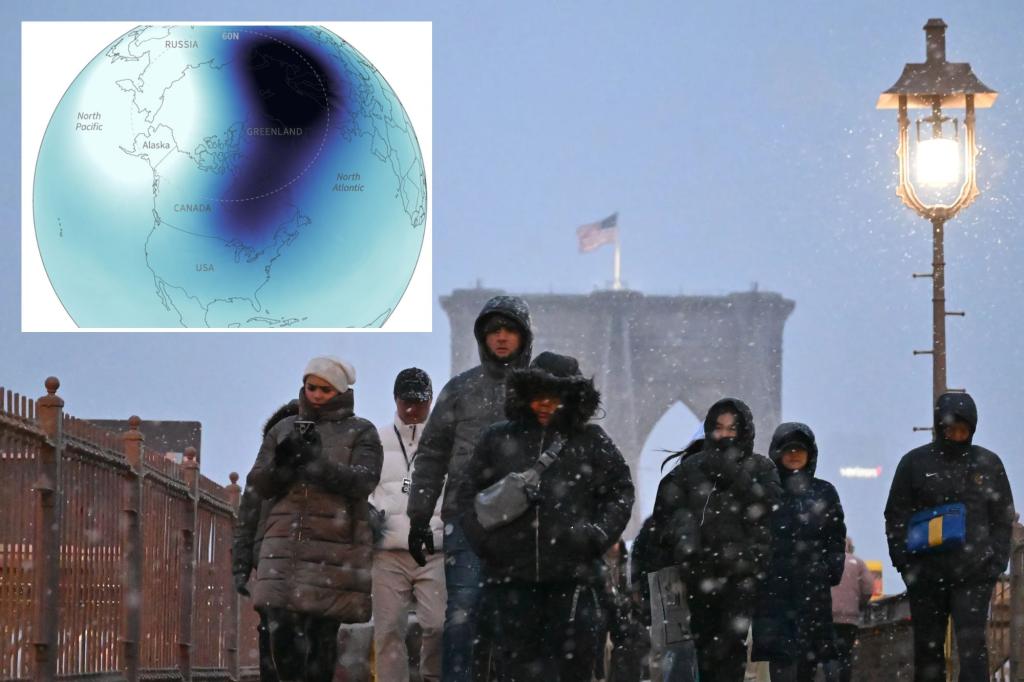Dust off the parkas.
After a mild December, the polar vortex is expected to send an Arctic blast to the United States later this week.
“That polar jet will be pushed further south, and guess what it does? Open the freezer door,” said FOX Weather Meteorologist Kendall Smith. “So all that cold, arctic air that’s been pent up right over Canada, right over the Arctic, is going to make its way into the lower 48 states.”
According to the FOX Forecast Center, this will likely be the coldest air felt in the lower 48 states so far this winter.
Cold weather begins late in the week in the Intermountain West and then moves into the central United States early next week.
The chilly air will linger for a while.
How cold will it be?
Weekend temperatures could fall 30 to 50 degrees below average for this time of year in some places.
The wind chill could reach -50 degrees in several places.
The Climate Prediction Center’s temperature outlook shows well below average temperatures in Minneapolis, Kansas City, Little Rock in Arkansas, Nashville in Tennessee and Chicago through January 18.
People walking in the snow on the Brooklyn Bridge during the winter storm on January 6, 2023. Paul Martinka
Why has the winter been mild and what is changing that?
El Niño is partly to blame for the mild winter recorded so far in the United States.
According to NOAA, during an El Niño winter, temperatures in the northern US are typically warmer and drier than average. The jet stream generally flows more from west to east.
“So we were very lucky for a good part of the month of December and even into early January, but now it’s been kind of a turning of the page, so to speak, a complete flip of the script,” Smith said. “Because now we are starting to see that cold air that has been trapped over Canada and over the Arctic. “That’s going to start to change.”
About two weeks ago, the Arctic experienced a sudden, minor stratospheric warming.
The air in the stratosphere, a layer of Earth’s atmosphere about 19 miles above the surface, warmed 55 degrees over a six-day period, wrote Amy Butler of NOAA’s Chemical Sciences Laboratory. That slowed the polar vortex winds.
About every two years, weather events in the lower atmosphere send strong atmospheric waves into the stratosphere, which interact with the polar vortex.
The polar vortex is a band of strong winds surrounding the North Pole. A constant, stable turn of those winds keeps the Arctic air locked in place.
When winds slow and become unstable, like a top, the vortex wobbles.
 The polar vortex on the left was from January 1 and the one on the right is the forecast for January 14 showing cold air spreading south. NOAA Climate.gov
The polar vortex on the left was from January 1 and the one on the right is the forecast for January 14 showing cold air spreading south. NOAA Climate.gov
The stratospheric climate is ahead of ours by up to two weeks, according to Judah Cohen, an atmospheric scientist at Verisk Atmospheric and Environmental.
“A disruption of the polar vortex called sudden stratospheric warming, where a very dramatic warming occurs at the North Pole of the stratosphere, and the polar vortex then migrates southward, away from where it is normally located at the North Pole, toward the south. . Cohen said. “And the cold air can then move south and then at the surface, that will often manifest itself in a negative Arctic oscillation.”
During the Big Texas Freeze in February 2021, the Arctic Oscillation reached its lowest and most negative reading in eight years.
According to NOAA, nor’easters are also related to the Arctic Negative Oscillation phase.
How long will the dangerous cold last?
It is still unclear how long the cold air remains in place, beyond a week.
“However, there remains considerable uncertainty about how the polar vortex will evolve after mid-January,” Butler wrote. “Meanwhile, there are signs that even this minor warming may help bolster the chances of colder weather patterns in some areas over the next two weeks. Stay tuned!”
Categories: Trending
Source: vtt.edu.vn
